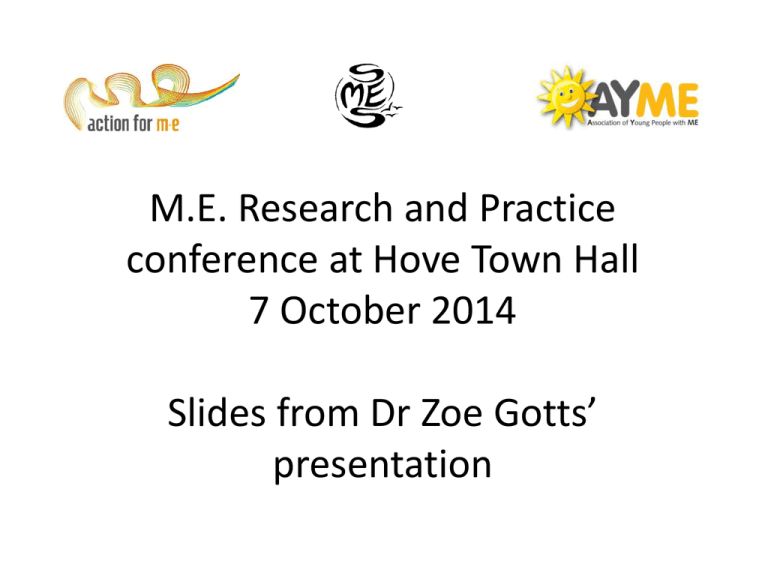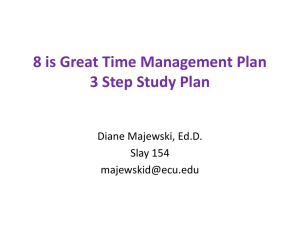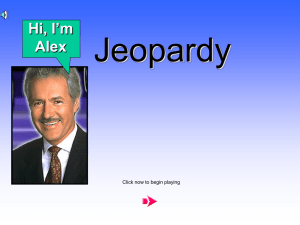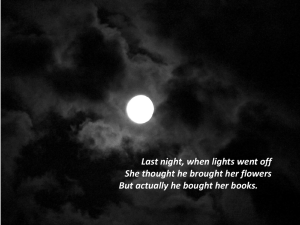
M.E. Research and Practice
conference at Hove Town Hall
7 October 2014
Slides from Dr Zoe Gotts’
presentation
Assessing & treating sleep disturbance
in M.E./CFS
M.E. Research & Practice
7th October 2014
Dr Zoe Gotts
Northumbria Centre for Sleep Research
(NCSR)
Northumbria Centre for Sleep Research
Northumbria Centre for Sleep Research
•
Exciting field to work in – research teams committed to engaging with patients
•
North East team of researchers & clinicians working together
•
Newcastle University Fatigue Research Centre
•
Wider research focus – researchers/clinicians outside of the field getting involved
•
Multidisciplinary collaboration
•
This is how the research is being driven (other Universities may follow suit…)
Northumbria Centre for Sleep Research
•
Newcastle University Fatigue Research Centre
–
Institute of Cellular Medicine
–
Institute of Neuroscience
–
Northumbria Centre for Sleep Research
- HPA axis
- autonomic dysfunction
- Immune system
- neuropsychological performance
- mitochondrial genomics
- sleep
•
CRESTA (Clinics for Research & Service in Themed Assessments)
- pain
- muscles/physiotherapy
- Investigating and managing fatigue
Researchers & clinicians
working together to better
understand the causes
and impact of CFS/ME &
to improve treatment
Researchers and students in discussion at the research presentations
Northumbria Centre for Sleep Research
• 3-year programme of research supported my Action for ME
• UNN & NCL collaboration
• Allowed me to focus in depth on one aspect of this condition – sleep
• UK CMRC – invited to be a member of the exec board (early career researcher)
Key research questions
• what kinds of sleep abnormalities?
• are these the same for all patients?
• do these impact upon existing symptoms?
• is it possible to assess sleep in a better way?
Northumbria Centre for Sleep Research
Objective sleep
studies
Sleep patterns &
severity differ
(32 x PSG)
94% Sleep
disturbance*
Some evidence of objective
sleep abnormalities - but
no consistent pattern!
Exacerbates
symptoms
(physical/mental
fatigue, pain,
cognitive)
PSG, polysomnography
*Rates from National Outcomes Database; 94% patients report disturbed sleep/unrefreshing sleep during assessment.
- early, middle, late insomnia.
- reversed/irregular insomnia
- oversleeping
- frequent awakenings,
- loss of restorative feelings.
Northumbria Centre for Sleep Research
Mixed methods approach
1.
Qualitative Interviews with patients
2.
Subjective sleep - 101 Sleep Diaries
3.
Objective sleep - 343 Polysomnography (PSG) recordings
4.
Detailed sleep assessment (feasibility) study
Northumbria Centre for Sleep Research
• Aim: Understand the extent to which sleep, its management & problems, are linked to
the lived experience of ME/CFS & how it interacts with other symptoms.
• No existing in-depth sleep-specific qualitative studies!
• A good starting point in my research with ME/CFS patients
• 11 Qualitative Interviews with ME/CFS patients
• Face-to-face (patient’s home/university), telephone, Skype
• Thematic analysis
• Under review. . .
Frequency in
group
N (%)
P1
4 (36.4%)
9 (82%)
P2
P3
P4
P5
P6
P7
P8
P9
P10
P11
Sleep Continuity Problems
SOL problem
Frequent
Awakenings/Broken
Sleep
WASO
(long duration)
3 (27.3%)
Extended sleep
duration
3 (27.3%)
Short sleep duration
6 (54.5%)
Waking too early
6 (54.5%)
Napping
6 (54.5%)
Vivid dreaming
4 (36.4%)
Mentally Alert
(during sleep)
5 (45.5%)
Temperature
5 (45.5%)
Pain During Sleep
5 (45.5%)
Sleep Disturbers
Changes over course of illness
10 (90.9%)
Nature and frequency of sleep problems and factors that disturb sleep in the sample of patients (N = 11)
SOL, sleep onset latency; WASO, wake after sleep onset
Frequency in
group
N (%)
P1
4 (36.4%)
9 (82%)
P2
P3
P4
P5
P6
P7
P8
P9
P10
P11
Sleep Continuity Problems
SOL problem
Frequent
Awakenings/Broken
Sleep
WASO
(long duration)
3 (27.3%)
Extended sleep
duration
3 (27.3%)
Short sleep duration
6 (54.5%)
Waking too early
6 (54.5%)
Napping
6 (54.5%)
Vivid dreaming
4 (36.4%)
Mentally Alert
(during sleep)
5 (45.5%)
Temperature
5 (45.5%)
Pain During Sleep
5 (45.5%)
Sleep Disturbers
Changes over course of illness
10 (90.9%)
Nature and frequency of sleep problems and factors that disturb sleep in the sample of patients (N = 11)
SOL, sleep onset latency; WASO, wake after sleep onset
Variation between individuals
Variability over illness course
Disturbers of sleep
Sleep
disturbances
Balancing activity
Adaptation & accepting disturbed
sleep
Alternative treatment approaches
“ Sleep central to
Attempts at wellbeing…
coping &
sleep direct bearing on
management
course &
progression of
illness ”
Maintenance/exacerbation of
symptoms
Effect on
daytime
functioning
Main themes & sub-themes elicited from patient narratives
Impact on QOL and living
Beliefs about impact on daytime
functioning
Sleep disturbances were highly unpredictable and variable
over time, but played a key role in
symptom experience.
Word cloud of Patient narratives
• Aim: Examine subjective sleep quality in ME/CFS and its associations with key
dimensions of the illness experience (fatigue, sleepiness, cognitive functioning,
mood)
• 101 patients (16-68 yrs, 81.2% female)
• Standardised sleep diary over 14 days
• Functional Assessments:
Fatigue (Chalder)
Sleepiness (ESS)
Cognitive functioning (CFQ, TMT)
Mood (HADS)
• Considerable variability in sleep characteristics across sample
• 79.2 % patients napping during the day! (39.55±55.35 min)
Mostly in the afternoon-evening period (31.74±43.94 min)
• Total duration of daytime napping (particularly in the PM) had a negative impact on
patients’ daytime cognitive functioning and levels of sleepiness
• Shorter illness length & longer wake time (during sleep period) associated with more fatigue
(adjustment?)
Gotts, Z M, Ellis, J G, Brannan, K, Newton, J L, & Deary, V (2013). Daytime Napping Impairs Cognitive Functioning in Chronic Fatigue Syndrome (CFS). UK Society
for Behavioural Medicine (UKSBM) 9th Annual Scientific Meeting, 9-10 December 2013, Oxford, p.76.
Aims:
1. Identify whether sleep-specific phenotypes exist in ME/CFS;
2. Explore objective characteristics that could differentiate phenotypes
(whilst also being relevant to routine clinical practice)
• Secondary analysis of existing PSG data from fatigue clinic in Holland
• 343 (single-night) PSG recordings
• Largest ME/CFS PSG dataset to date!
Gotts Z M, Deary V, Newton J L, Van der Dussen D, De Roy P, & Ellis J G (2013). Are there sleep-specific phenotypes in patients with chronic fatigue syndrome?
A cross-sectional polysomnography analysis. BMJ Open, 3(6).
343 First-night single PSGs performed on a sample of referrals to a
fatigue service
101 Suspected
Apnoea*
(AHI>15)
239
Unexplained
17 Suspected
PLMs*
(PLMI>5)
30%
Primary Sleep Disorder
Figure 1: Study Overview
*AASM, American Academy of Sleep Medicine. PLM, periodic leg movement
343 First-night single PSGs performed on a sample of referrals to a
fatigue service
101 Suspected
Apnoea*
(AHI>15)
239
Unexplained
Age = 34.4 (SD 11.84)
Sex = 210 (87.9%) Female
BMI = 23.54 (SD 4.26)
AHI = 4.5 (SD 4.11)
PLM Index = 1.01 (SD 0.9)
TST = 435.22 (SD 242.65)
WAKE TIME = 85.78 (SD 64.44)
SEI = 83.04 (SD 13.04)
SL = 28.05 (SD 30.31)
WASO = 57.44 (SD 62.46)
Number of Awakenings = 11.82 (SD 8.48)
Number of Arousals per/hour = 6.64 (SD 16.01)
%N1 of TST = 15.10 (SD 11.81)
%N2 of TST = 37.74 (SD 12.60)
%N3 of TST = 32.11 (SD 13.44)
%REM of TST = 15.32 (SD 6.41)
REM Latency = 65.19 (87.35)
Figure 1: Study Overview
17 Suspected
PLMs*
(PLMI>5)
Sleep profile
highly variable
indicating presence
of phenotypes
343 First-night single PSGs performed on a sample of referrals to a
fatigue service
101 Suspected
Apnoea*
(AHI>15)
WASO ≥30 min
problematic
(Edinger et al., 2004)
Figure 1: Study Overview
239
Unexplained
Age = 34.4 (SD 11.84)
Sex = 210 (87.9%) Female
BMI = 23.54 (SD 4.26)
AHI = 4.5 (SD 4.11)
PLM Index = 1.01 (SD 0.9)
TST = 435.22 (SD 242.65)
WAKE TIME = 85.78 (SD 64.44)
SEI = 83.04 (SD 13.04)
SL = 28.05 (SD 30.31)
WASO = 57.44 (SD 62.46)
Number of Awakenings = 11.82 (SD 8.48)
Number of Arousals per/hour = 6.64 (SD 16.01)
%N1 of TST = 15.10 (SD 11.81)
%N2 of TST = 37.74 (SD 12.60)
%N3 of TST = 32.11 (SD 13.44)
%REM of TST = 15.32 (SD 6.41)
REM Latency = 65.19 (87.35)
17 Suspected
PLMs*
(PLMI>5)
343 First-night single PSGs performed on a sample of referrals to a
fatigue service
101 Suspected
Apnoea*
(AHI>15)
Normal parameters
N1: 2-5%
N2: 45-55%
N3: 13-23%
REM: 20-25%
(Carskadon & Dement, 2011)
Figure 1: Study Overview
239
Unexplained
Age = 34.4 (SD 11.84)
Sex = 210 (87.9%) Female
BMI = 23.54 (SD 4.26)
AHI = 4.5 (SD 4.11)
PLM Index = 1.01 (SD 0.9)
TST = 435.22 (SD 242.65)
WAKE TIME = 85.78 (SD 64.44)
SEI = 83.04 (SD 13.04)
SL = 28.05 (SD 30.31)
WASO = 57.44 (SD 62.46)
Number of Awakenings = 11.82 (SD 8.48)
Number of Arousals per/hour = 6.64 (SD 16.01)
%N1 of TST = 15.10 (SD 11.81)
%N2 of TST = 37.74 (SD 12.60)
%N3 of TST = 32.11 (SD 13.44)
%REM of TST = 15.32 (SD 6.41)
REM Latency = 65.19 (87.35)
17 Suspected
PLMs*
(PLMI>5)
Confirms objective
sleep difficulties in
this sample!
Cluster Analysis
Iteration Process
• 154 Groups in Primary (First-step) Iteration
• 39 Groups in Second Iteration
• 9 Groups in Third Iteration
• 9 Groups in Fourth Iteration
• 8 Groups in Fifth Iteration
Retain minimum 5% of sample per group
• 4 Groups in Sixth Iteration
• 2 Groups in Seventh Iteration
• 2 Groups in Eighth Iteration
• 2 Groups in Ninth Iteration
• 2 Groups in Tenth Iteration
• 2 Groups in Eleventh Iteration
• 2 Groups in Twelfth Iteration
• 2 Groups in Thirteenth Iteration
• 2 Groups in Fourteenth (Final) Iteration
Sleep Phenotypes
Key Characteristics
• Type 1 – Long sleep onset, few awakenings, normal quality (Sleep Onset Insomnia?)
• Type 2 – Restless, high N2, arousals, normal quality (NRS) (pain patients/noise sensitivity?)
• Type 3 – Few awakenings, lots of deep sleep (Hypersomnolence*?)
• Type 4 – Lots of awakenings, short sleep duration (Sleep Maintenance Insomnia?)
1
4
10%
6%
23%
61%
*The term Hypersomnolence will replace hypersomnia under the DSM-5
3
2
Sleep Phenotypes
Length of illness?
• Type 1 – Long sleep onset, few awakenings, normal quality (Sleep Onset Insomnia?)
• Type 2 – Restless, high N2, arousals, normal quality (NRS) (pain patients/noise sensitivity?)
• Type 3 – Few awakenings, lots of deep sleep (Hypersomnolence*?)
• Type 4 – Lots of awakenings, short sleep duration (Sleep Maintenance Insomnia?)
Patients may fall into more than one of these sleep-types - at different stages of their illness
*The term Hypersomnolence will replace hypersomnia under the DSM-5
Sleep Phenotypes
Importantly!
Amenable to different kinds of treatment
• Type 1 – Long sleep onset, few awakenings, normal quality (Sleep Onset Insomnia?)
• Type 2 – Restless, high N2, arousals, normal quality (NRS) (pain patients/noise sensitivity?)
• Type 3 – Few awakenings, lots of deep sleep (Hypersomnolence*?)
• Type 4 – Lots of awakenings, short sleep duration (Sleep Maintenance Insomnia?)
• Therapeutic / Pharmacological Interventions?
• Standalone / adjunct?
*The term Hypersomnolence will replace hypersomnia under the DSM-5
Northumbria Centre for Sleep Research
Detailed Sleep Assessment
12-month
study period
Flow Diagram of Study (recruitment, protocol and analytical) Process
OSA, obstructive sleep apnea; PSG, polysomnography; CAR, cortisol awakening response
12-month
study period
Flow Diagram of Study (recruitment, protocol and analytical) Process
OSA, obstructive sleep apnea; PSG, polysomnography; CAR, cortisol awakening response
12-month
study period
Flow Diagram of Study (recruitment, protocol and analytical) Process
OSA, obstructive sleep apnea; PSG, polysomnography; CAR, cortisol awakening response
Sequence of performing the polysomnograph
4
Polysomnography (PSG) is the
most important laboratory
technique for assessment of
sleep and its disorders.
• EEG, EOG, chin EMG
• Thermal flow & pressure
sensor (applied shortly
before bedtime)
• Snore sensor
1
24
PSG records multiple
physiological characteristics
simultaneously during sleep.
• ECG
• Thoracic & abdominal belts
• Position sensor
Applying the electrodes and
sensors is the most important
part of the sleep study to
ensure quality data.
3
• Pulse Oximeter (appled
shortly before bedtime)
• Actiwatch (additional to PSG)
4
• Leg EMG
Reassure the patient and explain what each sensor measures
REM
Fig. 1.: PSG data - EEG signals (electrodes T3, T4, FPZ, FP1, FP2, F3, F4, CZ, C3, C4, P3, P4, O1, O2), EOG & EMG
signals, ECG and the respiration signals.
Preliminary sleep data
Main Outcome Measures of interest (nights 2 & 3 only):
–
–
–
–
Total Sleep Time
Sleep Onset Latency
Awakenings – number & duration
Sleep Efficiency (%)
– % of each stage & wake (of TSP)
– REM Latency
– Stage transitions
TSP, total sleep period; NREM, non rapid eye movement; REM, rapid eye movement
Sleep Continuity
Sleep Architecture
Preliminary sleep data
Comparison of Patients & Controls
Sleep Variable
CFS Group (N = 19)
Mean
SD
SOL (min)
WASO (min)
TST (min)
Percentage N1 (of TST)
Percentage N2 (of TST)
Percentage SWS (of TST)
Percentage REM (of TST)
Percentage WAKE (of TSP)
REM latency (min)
SEI (%)
NWAK (over TSP)
22.47
27.13
453.91
4.57
53.81
17.74
23.89
11.27
141.20
92.53
17.97
20.49
24.32
73.74
2.26
10.57
9.74
5.80
5.74
70.60
4.18
7.90
Control Group (N =22)
Mean
SD
13.56
14.84
434.13
3.52
52.96
19.68
23.91
6.03
95.88
96.78
13.66
10.08
11.14
30.02
1.23
4.53
4.24
4.01
3.11
35.73
2.07
5.07
t
df
p
-1.73
-3.68
-1.15
-1.80
-.33
.81
.01
-3.70
-2.53
4.03
-2.11
25.36
24.43
39
27.26
23.65
23.83
39
39
25.76
25.46
39
.10 ns
.001**
.29 ns
.08 ns
.75 ns
.43 ns
.99 ns
.001**
.018*
.000***
.041*
Independent samples t–test for the objectively-derived sleep variables (mean night 2 & night 3), between patients (CFS) and control participants.
Awakenings a key feature!
Controls lab-based but ok not looking at N1 eliminate first-night effect
*p ˂ .05, ** p ˂ .01, *** p ˂ .001. SOL, sleep onset latency; WASO, wake after sleep onset; TST, total sleep time; N1, stage 1 sleep; N2, stage 2 sleep; SWS, slow wave sleep; REM, rapid eye movement sleep; SEI, sleep
efficiency index; TSP, total sleep period; NWAK, number of awakenings
Main outcomes
4
• Was the sleep assessment feasible?
•
YES! Successful protocol: methods acceptable to patients
•
No drop-outs, highly motivated
•
Tolerated procedures (minor considerations)
•
Adherence to sleep & cortisol protocol / Fidelity to timing
4
• Preliminary sleep data:
•
Increased amounts of light sleep & wakefulness
•
Established temporal stability of sleep variables over 2 nights
•
Cortisol data currently being analysed
• Possible to develop future trial with this protocol
Research
Clinic
• Established a feasible (comprehensive) protocol
to assess sleep & cortisol in ME/CFS
• Need to routinely screen for PSDs in patients
presenting with ME/CFS – early on!
• 1 night affords detection of PSD
• Different groups (sleep phenotypes) with different
sleep profiles that may be treated for their sleep in
different ways
• 2 nights sufficient to capture sleep physiology of
patients
• Consider daytime sleep (24h PSG assessment )
• ‘Light sleep’ a feature throughout – follow up
potential issues with cortical arousal?
• Consider sleep in the context of other factors
(i.e. adjustment to illness, severity of illness, differential management)
• Clinicians should be mindful of these sleepphenotypes when tailoring sleep-based interventions
for ME/CFS patients
• Target disturbed sleep & napping during treatment
may improve other symptoms (i.e. fatigue , cog functioning)
Current Work
…Applying the research in a clinical setting
CRESTA Fatigue Clinic
(Clinics for Research and Service in Themed Assessment)
Development of a sleep intervention for people with ME/CFS
Supported by the ME Association
Acknowledgements
Prof Julia Newton
Dr Vincent Deary
Prof Jason Ellis
Dr Mark Wetherell
Dr Pierre de Roy and his team, VermoeidheidCentrum, Lelystad
Study Participants
Funding: Action for ME, ME Association
Northumbria Centre for Sleep Research
Stay Connected…
Contact..
Find us..
zoe.gotts@northumbria.ac.uk
Northumbria Centre for Sleep Research
ME / CFS Research Newcastle
Follow us..
@NCSR_Sleep
@MECFSResNew








